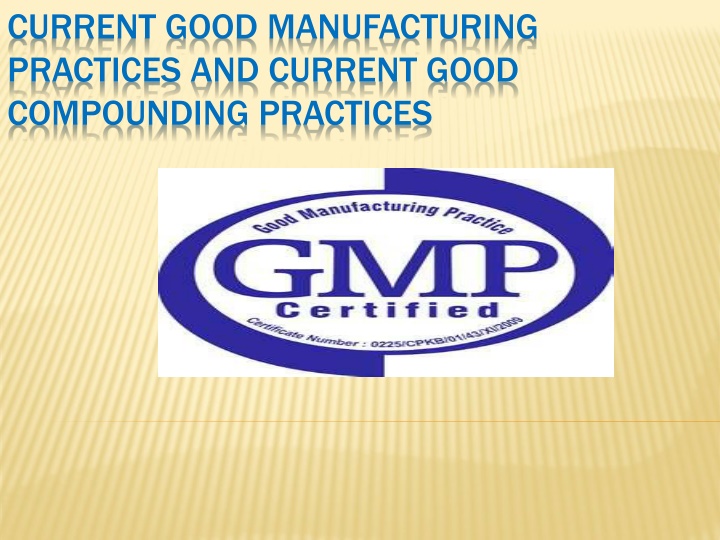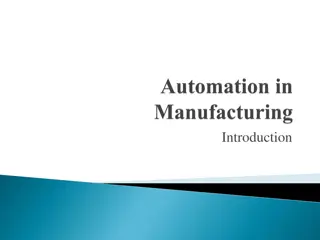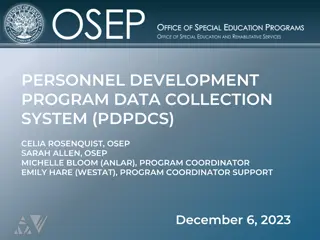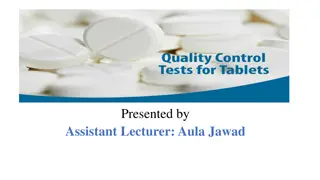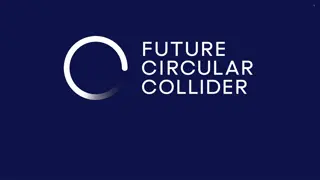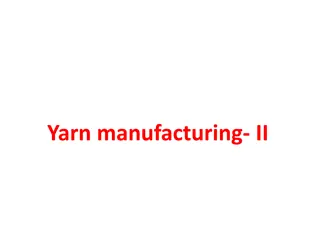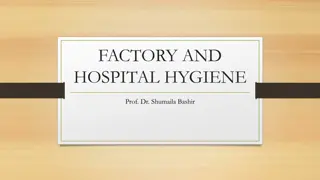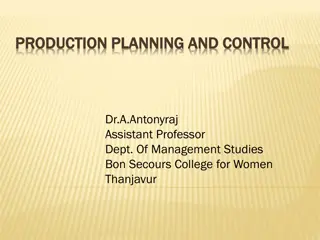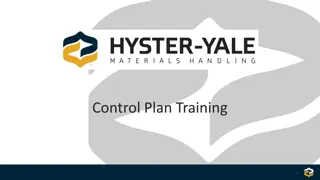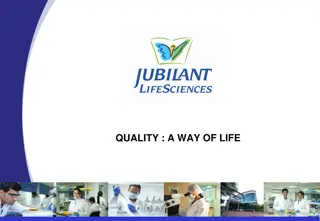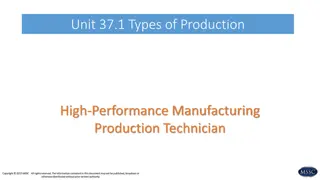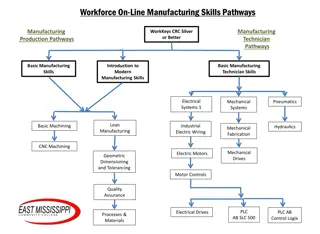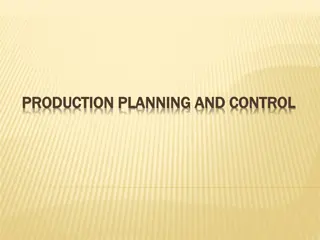Quality Control and Personnel Responsibilities in Manufacturing Practices
Standards for Current Good Manufacturing Practice (cGMP) regulations ensure drug product quality in the U.S. The organization and personnel section outlines responsibilities for quality control and personnel in manufacturing. The head of production and quality control departments have distinct responsibilities to maintain quality standards, ensure proper documentation, training, and validation, and monitor equipment and facilities.
Download Presentation

Please find below an Image/Link to download the presentation.
The content on the website is provided AS IS for your information and personal use only. It may not be sold, licensed, or shared on other websites without obtaining consent from the author.If you encounter any issues during the download, it is possible that the publisher has removed the file from their server.
You are allowed to download the files provided on this website for personal or commercial use, subject to the condition that they are used lawfully. All files are the property of their respective owners.
The content on the website is provided AS IS for your information and personal use only. It may not be sold, licensed, or shared on other websites without obtaining consent from the author.
E N D
Presentation Transcript
CURRENT GOOD MANUFACTURING PRACTICES AND CURRENT GOOD COMPOUNDING PRACTICES
STANDARDS FOR CURRENT GOOD MANUFACTURING PRACTICE *Current Good Manufacturing Practice (cGMP or GMP) regulations are established by the Food and Drug Administration (FDA) to ensure that minimum standards are met for drug product quality in the United States. The first GMP regulations were promulgated in 1963 under the provisions of the Kefauver-Harris Drug Amendments and since then they have been periodically updated. *The cGMP regulations establish requirements for all aspects of pharmaceutical manufacture. They apply to domestic and to foreign suppliers and manufacturers whose bulk components and finished pharmaceutical products are imported, distributed, or sold in this country.
ORGANIZATION AND PERSONNEL The organization and personnel section of the regulations deals with the responsibilities of the quality control unit, employees, and consultants. The regulations require that a quality control unit have the authority and responsibility for all functions that may affect product quality. This includes accepting or rejecting product components, product specifications, finished products, packaging, and labeling. *All personnel engaged in the manufacture, processing, packing, or holding of a drug product, including those in supervisory positions, are required to have the education, training, and/or experience needed to fulfill the assigned responsibility.
~ ~ head of production department has generally the following responsibilities:- a) to ensure that products are manufactured and stored according to the appropriate documentation; b) to ensure that the necessary training of production personnel is carried out and adapted; c) to approve the instructions relating to production operations and to ensure their strict implementation; d) to ensure that the production records are evaluated and signed by a designated person . e) To check the maintenance of his department, premises, and equipment; f) to ensure that the appropriate validation and calibration of control equipment is performed and recorded.
~ ~ head of the quality control department generally has the following responsibilities:- a) to approve specifications, sampling instructions, test methods, and other procedures ; b) to ensure that all necessary testing is carried out; c) to approve or reject, starting materials, packaging materials, and intermediate, bulk and finished products; d) to evaluate batch records. e) to approve and monitor analyses carried out under contract; f) to check the maintenance of the department, premises and equipment; g) to ensure that appropriate validations, including those of analytical procedures, and calibration of control equipment are done; h) to ensure that the necessary training of quality control personnel is carried out and adapted.
Training :- *Training should be in accordance with written programs approved by the production manager and as appropriate by quality manger. * A special attention should be given to training of operators working in aseptic or clean areas, or with highly potent materials. * Training should be given at recruitment and be augmented and revised as necessary. * Periodic assessments of the effectiveness of training programs. Health of personnel :- * There shall be a suitable health program for medical checks for personnel before and during their employment. * The type of medical check shall depend on the nature of work done by the employee.
BUILDINGS AND FACILITIES *Each building's structure, space, design, and placement of equipment must be such to enable thorough cleaning, inspection, and safe and effective use for the designated operations. *Proper considerations must be given to such factors ((as water quality standards; security; materials used for floors, walls, and ceilings; lighting; segregated quarantine areas for raw materials and product components subject to quality control approval; holding areas for rejected components; storage areas for released components; weighing and measuring rooms; sterile areas for ophthalmic and parenteral products; flammable materials storage areas; finished products storage; control of heat, humidity, temperature, and ventilation; waste handling; employee facilities ))
EQUIPMENT *Each piece of equipment must be of appropriate design and size and suitably located to facilitate operations for its intended use, cleaning, and maintenance. The equipment's surfaces and parts must not interact with the processes or product's components so as to alter the purity, strength, or quality. *Automated equipment and computers used in the processes must be routinely calibrated, maintained, and validated for accuracy. *Filters used in the manufacture or processing of injectable drug products shall not release fibers into such products. If fiber- releasing filters must be used, non-fiber-releasing filters also must be used to reduce any fiber content.
* * Equipment should be installed in such a way as to minimize any risk of error or of contamination. * * Equipment should be kept or stored in a clean condition and be checked for cleanliness prior to each use. * * Defective equipment, if possible, should be removed from production and quality control areas, or labeled as defective. * * Equipment used for weighing, measuring, testing and re-cording should be subject to regular recorded checks for accuracy and working order * * Fixed pipe work (and valves) should be clearly labeled to indicate the contents, and the direction of flow. * *Washing and cleaning equipment should be chosen and used in order not to be a source of contamination.
CONTROL OF COMPONENTS, CONTAINERS, AND CLOSURES *Bulk pharmaceutical chemicals, containers, and closures must meet the exact physical and chemical specifications established with the supplier at the time of ordering. *When product components are received from a supplier, each lot must be logged in with the order number, date of receipt, bill of lading, name and vital information of the supplier, supplier's stock or control number, and quantity received. *The component is assigned a control number that identifies both the component and the intended product. *Rejected components, drug product containers, and closures are identified and controlled under a quarantine system to prevent their use in manufacturing and processing operations.
PRODUCTION AND PROCESS CONTROLS *Written procedures are required for production and process controls to ensure that the drug products have the correct identity, strength, quality, and purity. These procedures, which include the charge-in of all components, use of in-process controls, sample testing, and process and equipment validation, must be followed for quality assurance. Any deviation from the written procedures must be recorded and justified. *All product ingredients, equipment, and drums or other containers of bulk finished product must be distinctively identified by labeling as to content and/or status.
~~In-process controls are of two general types: (a) those performed by production personnel at the time of operation to ensure that the machinery is producing output within preestablished control limits (e.g., tablet size, hardness) (b) those performed by the quality control laboratory personnel to ensure compliance with all product specifications (e.g., tablet content, dissolution) and batch-to-batch consistency.
PACKAGING AND LABELING CONTROL * Labeling for each variation in drug product strength, dosage form, or quantity of contents must be stored separately with suitable identification. outdated labels and other packaging materials must be destroyed. Access to the storage area must be limited to authorized personnel. Each label must contain expiration dating and the production batch or lot number to facilitate product identification. Special packaging requirements may apply in certain instances, as with tamper-evident packaging for over-the-counter (OTC) products.
Expiration Dating To ensure that a drug product meets applicable standards of identity, strength, quality, and purity at the time of use, it must bear an expiration date determined by appropriate stability testing. Tamper-Evident Packaging the cGMP regulations require tamper-evident packaging for OTC drug products to improve their security and to ensure their safety and effectiveness. A tamper-evident package is one having one or more indicators or barriers to entry which, if breached or missing, can reasonably be expected to provide visible evidence to consumers that tampering has occurred.
HOLDING AND DISTRIBUTION Products must be stored and shipped under conditions that do not affect product quality. Ordinarily, the oldest approved stock is distributed first. The distribution control system must allow the distribution point of each lot of drug product to be readily determined to facilitate its recall if necessary. LABORATORY CONTROLS Laboratory controls are requirements for the establishment of written specifications, standards, sampling plans, test procedures, and other such mechanisms. * The specifications, which apply to each batch of drug product, include provisions for sample size, test intervals, sample storage, stability testing, and special testing requirements for certain dosage forms * Reserve samples must be maintained for 1 to 3 years after the expiration date of the last lot of the drug product.
RECORDS AND REPORTS Production, control, and distribution records must be maintained for at least a year following the expiration date of a product batch. This includes equipment cleaning and maintenance logs; specifications and lot numbers of product components, including raw materials and product containers and closures; and label records. *These master records must document that each step in the production, control, packaging, labeling, and distribution of the product was accomplished and approved by the quality control unit. *Depending on the operation, the operator's and/or supervisor's full signatures, or other written or electronic identification codes are required.
RETURNED AND SALVAGED DRUG PRODUCTS Returned drug products (e.g., from wholesalers) must be identified by lot number and product quality determined through appropriate testing. ((Drug products that meet specifications)) may be salvaged or reprocessed. ((Those that do not, along with those that have been subjected to improper storage (e.g., extremes in temperature), shall not be returned to the marketplace.
INFORMATION TECHNOLOGY AND AUTOMATION Computers are used extensively in plant operations such as production scheduling, in-process manufacturing, quality control, and packaging and labeling. The networking of computers in the production and quality control areas fully integrates laboratory information and manufacturing operations into sophisticated management systems. These integrated systems support ((cGMP compliance, process validation, resource management, and cost control)).
ADDITIONAL CGMP REGULATORY REQUIREMENTS ACTIVE PHARMACEUTICAL INGREDIENTS AND PHARMACEUTICAL EXCIPIENTS Because the quality of any finished pharmaceutical product depends on the quality of the various components, including the active ingredients, compliance with cGMPs is a critical part of the FDA's preapproval inspection program for new drug applications (NDAs) and abbreviated new drug applications (ANDAs). * *Pharmaceutical excipients, as they, too, are components of finished pharmaceutical products, must be produced in accordance with cGMP standards as certified on the application by each sponsor of an NDA or ANDA.
^^ The application of the regulations is focused on all of the defining elements of chemical purity and quality, including the following :- *Specifications and analytical methods for all reactive and nonreactive components used in synthesis *Critical chemical reaction steps *Handling of chemical intermediates *Effect of scale-up of chemical batches on the yield *Quality of the water systems *Solvent handling and recovery systems *Analytical methods to detect impurities or chemical residues and the limits set *Stability studies of the bulk pharmaceutical chemical
CLINICAL TRIAL MATERIALS *The CTMs used in clinical investigations must be produced in compliance with the cGMP regulatory requirements and standardized as to identity, purity, strength, and quality . *However, during preclinical testing and the early phases of clinical evaluation, a product's formulation and many of the production processes and analytical controls are under development. Thus, during this period, the regulatory requirements are applied with flexibility. *As the clinical trials progress from Phase 1 to Phase 2, the processes are being characterized and refined, and during Phase 3 they are expected to meet all regulatory requirements. It is during Phase 3 that process optimization is demonstrated to the FDA by the production of at least one tenth of a commercial size batch (e.g., 100,000 capsules) of the proposed product.
BIOLOGICS cGMP standards are defined for biologic products in the Code of Federal Regulations .While the basic regulations for finished pharmaceuticals apply to biologic products as well, the nature of blood, bacterial, and viral products requires specific additional mandates. ((blood collection procedures; environmental controls; cell bank and cell line characterization and testing; cell propagation and fermentation; inactivation of infectious agents; aseptic processing validation ; live vaccine work areas; work with spore-bearing organisms; and evaluation, quantification, and validation of risk factors)).
MEDICAL DEVICES Medical devices follow a path for FDA approval that resembles that for pharmaceuticals. For instance, clinical investigations of devices are conducted on approval of an investigational device exemption and approved for marketing when shown to be safe and effective through a premarket approval application, similar to an investigational new drug and NDA, respectively. ~~Devices covered by cGMP regulations include ((intraocular lenses, hearing aids, intrauterine devices, cardiac pacemakers, clinical chemistry analyzers, catheters, dental X- ray equipment, surgical gloves, condoms, traction equipment, computed tomography equipment)).
cGMP REQUIREMENTS FOR MANUFACTURING IN PHARMACIES Pharmacies that engage in such activities must register with the FDA as a manufacturer or distributor and be subject to FDA inspection at regular intervals. Included are hospital pharmacies that repackage drug products for their own use and for the use of other hospitals; chain pharmacy operations that repackage and relabel bulk quantities of products for distribution in the chain; and similar repackaging and relabeling by individual pharmacists or pharmacies for distribution to other pharmacies or retailers. *Recently, professional attention has been directed toward differentiating between pharmaceutical manufacturing and compounding as practiced by community pharmacists . *Pharmaceutical manufacturing is ((large-scale production of drugs or drug products for distribution and sale)), whereas compounding is ((professional preparation of prescriptions for specific patients as a part of the traditional practice of pharmacy)).
CURRENT GOOD COMPOUNDING PRACTICES pharmacists have increased the practice of compounding patient-specific medications. An increase in the incidence of pharmaceutical compounding was noted in the 1970s. *As the extent of compounding increased, many standard- setting agencies and regulatory bodies wanted to ensure quality compounded products; consequently, there was a lot of activity during the mid 1990s to establish guidelines for pharmaceutical compounding.
A number of reasons have been presented for the increase in preparing patient-specific medications, including the following: *Many patients need drug dosages or strengths that are not commercially available. *Many patients need dosage forms are not commercially available. *Many patients are allergic to excipients in commercially available products. *Children's medications must be prepared as liquids, flavored to enhance compliance. *Some medications are not very stable and require preparation and dispensing every few days. *Many drugs are reported in the literature but are not manufactured yet. *Many physicians desire to deliver products in innovative ways, and pharmacists can work with them to solve medication problems. *Most products are not available for veterinary patients. *Home health care and the treatment of an increasing number of patients at home have resulted in many community pharmacies and home health care. *Hospice care has resulted in new approaches to pain management and higher concentrations and combinations of drugs that are now used. *Creating a specialized niche practice of pharmacy.
U.S. PHARMACOPEIA-NATIONAL FORMULARY In 2000, the U.S. Pharmacopeial Convention formed two compounding expert committees; one in nonsterile compounding and one in sterile compounding. *The Expert Committee on Sterile Compounding prepared the USP Pharmaceutical Compounding-sterile Preparations which first became official in 2004 . Additional chapters in the USP related to compounding include Good Compounding Practices, Quality Assurance in Pharmaceutical Compounding, and Pharmaceutical Calculations in Prescription Compounding.
Chapter Pharmacy Compounding, includes the following discussions: (a) compounding environment; (b) stability of compounded preparations; (c) ingredient selection and calculations; (d) checklist for acceptable strength, quality, and purity; (e) compounded preparations; (f) compounding process; (g) compounding records and documents; (h) quality control; (i) patient counseling. (a) (b) (c) (d) (e) (f) (g) (h)
NATIONAL ASSOCIATION OF BOARDS OF PHARMACY A) general provisions and definitions Compounding means the preparation of Components into a Drug product . Manufacturing means the production, preparation, propagation, conversion, or processing of a Drug or Device. (B), Organization and Personnel, discusses the responsibilities of pharmacists and other personnel engaged in compounding. (C), Drug Compounding Facilities, describes the areas that should be set aside for compounding, either sterile or not. D), Equipment, states that equipment used must be of appropriate design, adequate size, and suitably located
(E), Control of Components and Drug Product Containers and Closures, describes the packaging requirements for compounded products. (F), Drug Compounding Controls, discusses the written procedures to ensure that the finished products are of the proper identity, strength, quality, and purity. G), Labeling Control of Excess Products and Records and Reports, describes the various records and reports that are required under these guidelines. *Many individual states have used this model and implemented their own version. All pharmacists and pharmacy students should become familiar with the individual state requirements in the state in which they practice.
PACKAGING, LABELING, AND STORAGE OF PHARMACEUTICALS CONTAINERS Depending on the intended use and type of container, among the qualities tested are the following :- ~Physicochemical properties ~Light-transmission for glass or plastic ~Drug compatibility ~Leaching and/or migration ~Vapor transmission for plastics ~Moisture barrier ~Toxicity for plastics ~Valve, actuator, metered dose, particle size, spray characteristics, and leaks for aerosols ~Sterility and permeation for parenteral containers ~Drug stability for all packaging
^^ ^^ According to the USP, a container is that which holds the article and is or may be in direct contact with the article. The immediate container is that which is in direct contact with the article at all times. The closure is part of the container. ^^ ^^ The container, including the closure, should be clean and dry before it is filled with the drug. The container must not interact physically or chemically with the drug so as to alter its strength, quality, or purity beyond the official requirements. * *An example would be the sorption of lipophilic drugs, such as diazepam, to low density plastics resulting in a loss of drug that is available for administration. The problem can be avoided with the use of glass containers.
* *most pharmaceutical products are packaged in plastic . The modern compact-type container used for oral contraceptives, which contains sufficient tablets for a monthly cycle of administration and permits the scheduled removal of one tablet at a time, is a prime example of contemporary plastic packaging. * *Plastic bags for intravenous fluids, plastic ointment tubes, plastic film-protected suppositories, and plastic tablet and capsule vials are other examples. ^^ ^^The widespread use of plastic containers arose from a number of factors, including the following: * *Its advantage over glass in lightness of weight and resistance to impact, which reduces transportation costs and losses due to container damage * *The versatility in container design and consumer acceptance * *Consumer preference for plastic squeeze bottles in administration of ophthalmics, nasal sprays, and lotions * *The popularity of blister packaging and unit-dose dispensing, particularly in health care institutions
Among the problems encountered in the use of plastics in packaging are (a) permeability of the containers to atmospheric oxygen and to moisture vapor, (b) leaching of the constituents of the container to the internal contents, (c) absorption of drugs from the contents to the container, (d) transmission of light through the container, and (e) alteration of the container upon storage. ~ ~Agents frequently added to alter the properties of plastic include plasticizers, stabilizers, antioxidants, antistatic agents, antifungal agents, colorants, and others. * *Drug substances that are subject to oxidative degradation may undergo a greater degree of degradation when packaged in plastic than in glass * *Liquid pharmaceuticals packaged in permeable plastic may lose drug molecules or solvent to the container, altering the concentration of the drug in the product and affecting its potency.
^^ ^^ Leaching is a ((term used to describe the movement of components of a container into the contents)). * *Compounds leached from plastic containers are generally the polymer additives, such as the plasticizers, stabilizers, or antioxidants. * *Leaching may be influenced by temperature, excessive agitation of the filled container, and the solubilizing effect of liquid contents on one or more of the polymer additives . ^^ ^^ Sorption, a term ((used to indicate the binding of molecules to polymer materials, includes both adsorption and absorption)). Sorption occurs through chemical or physical means due to the chemical structure of the solute molecules and the physical and chemical properties of the polymer * *The un-ionized species of a solute has a greater tendency to be bound than the ionized species. * * pH may influence the sorption tendency of a particular solute . * *Plastic materials with polar groups are particularly prone to sorption. * *the pharmaceutical vehicle or solvent used can also play a role by altering the integrity of the plastic.
CHILD-RESISTANT AND ADULT-SENIOR USE PACKAGING A child-resistant container is defined as one that is significantly difficult for children under 5 years of age to open or to obtain a harmful amount of its contents within a reasonable time and that is not difficult for normal adults to use properly . The Consumer Product Safety Commission evaluates the effectiveness of such containers using children aged 42 to 51 months. The four basic designs commonly used are align the arrows, press down and turn, squeeze and turn, and latch top.
COMPLIANCE PACKAGING * *To assist patients in taking their medications on schedule, manufacturers and pharmacists have devised numerous educational techniques, reminder aids, compliance packages, and devices. * *The many factors associated with noncompliance include ((misunderstanding the dosing schedule, , confusion because the patient is taking multiple medications, , forgetfulness, , and a feeling of well-being leading to premature discontinuance of medication))
LABELING Different labeling requirements apply to investigational drugs, manufacturer's prescription dispensed prescription medication, OTC products, products for animals, medical devices, and other specific categories and specific products. In every instance, federal labeling requirements may be strengthened by state law. * *MANUFACTURER'S LABEL ((The established name of the drug , The name of the manufacturer, A quantitative statement of the amount of each drug , The pharmaceutical type of dosage form , The net amount of drug product contained in the package , The logo Rx only or a similar statement , A label reference to refer to the accompanying package , Special storage instructions , The National Drug Code identification number for the product , An identifying lot , An expiration date )). drugs, controlled substances,
* *PRESCRIPTION LABEL by federal law the pharmacist must include the following information on the label of the dispensed medication:((The name and address of the pharmacy, serial number of the prescription , date of the prescription , name of the prescriber , name of the patient , Directions for use , address of the patient , initials or name of pharmacist , telephone number of the pharmacy , drug name, strength, and manufacturer's lot , expiration date of the drug , name of the manufacturer or distributor , an effort to decrease medication errors . * *OVER-THE-COUNTER LABELING The label on the container of OTC products includes the following: ((Product name , Name and address of the manufacturer , Statement of the net quantity of the contents , Established names and quantities of all active ingredients , name of any habit-forming substance or substances in the preparation , Statement of pharmacologic category , Cautions and warnings , Sodium content for certain oral products , Storage conditions evident feature , Lot number and expiration date * *DIETARY SUPPLEMENT LABELING (( .
STORAGE To ensure the stability of a pharmaceutical preparation for the period of its intended shelf life: ~ ~Cold: temperature not exceeding 8 C (46 F). ~ ~freezer: temperature is maintained thermostatically between -25 - 10 C (-13 and 14 F). ~ ~Room temperature: temperature prevailing in a working area between 20 to 25 C (68 to 77 F). ~ ~Warm: temperature between 30 and 40 C (86 and 104 F). ~ ~Protection from freezing: to the risk of breakage of the container, freezing subjects a product to loss of strength or potency . TRANSPORTATION * * The stability protection of a pharmaceutical product during transportation is an important consideration. * * maintenance of satisfactory conditions of temperature and humidity during shipment is not always practiced .
